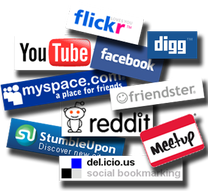Web 2.0
Today we are living in a society where we are using the internet as a tool where everyone can retrieve or add information.
Web 2.0 websites allow users to do more than just retrieve information. By increasing what was already possible in "Web 1.0", they provide the user with more user-interface, software and storage facilities, all through their browser. This has been called "Network as platform" computing. Users can provide the data that is on a Web 2.0 site and exercise some control over that data. These sites may have an "Architecture of participation" that encourages users to add value to the application as they use it.
The concept of Web-as-participation-platform captures many of these characteristics. Bart Decrem, a founder and former CEO of Flock, calls Web 2.0 the "participatory Web" and regards the Web-as-information-source as Web 1.0.
The impossibility of excluding group members who don’t contribute to the provision of goods from sharing profits gives rise to the possibility that rational members will prefer to withhold their contribution of effort and free-ride on the contribution of others. This requires what is sometimes called radical trust by the management of the website. According to Best, the characteristics of Web 2.0 are: rich user experience, user participation, dynamic content, metadata, web standards and scalability. Further characteristics, such as openness, freedom and collective intelligence by way of user participation, can also be viewed as essential attributes of Web 2.0. (http://en.wikipedia.org/wiki/Web_2.0#History)
Web 2.0 websites allow users to do more than just retrieve information. By increasing what was already possible in "Web 1.0", they provide the user with more user-interface, software and storage facilities, all through their browser. This has been called "Network as platform" computing. Users can provide the data that is on a Web 2.0 site and exercise some control over that data. These sites may have an "Architecture of participation" that encourages users to add value to the application as they use it.
The concept of Web-as-participation-platform captures many of these characteristics. Bart Decrem, a founder and former CEO of Flock, calls Web 2.0 the "participatory Web" and regards the Web-as-information-source as Web 1.0.
The impossibility of excluding group members who don’t contribute to the provision of goods from sharing profits gives rise to the possibility that rational members will prefer to withhold their contribution of effort and free-ride on the contribution of others. This requires what is sometimes called radical trust by the management of the website. According to Best, the characteristics of Web 2.0 are: rich user experience, user participation, dynamic content, metadata, web standards and scalability. Further characteristics, such as openness, freedom and collective intelligence by way of user participation, can also be viewed as essential attributes of Web 2.0. (http://en.wikipedia.org/wiki/Web_2.0#History)

Electronic mail, commonly called email or e-mail, is a method of exchanging digital messages from an author to one or more recipients. Modern email operates across the Internet or other computer networks. Some early email systems required that the author and the recipient both be online at the same time, a la instant messaging. Today's email systems are based on a store and forward model. Email servers accept, forward, deliver and store messages. Neither the users nor their computers are required to be online simultaneously; they need connect only briefly, typically to an email server, for as long as it takes to send or receive messages.
An email message consists of three components, the message envelope, the message header, and the message body. The message header contains control information, including, minimally, an originator's email address and one or more recipient addresses. Usually descriptive information is also added, such as a subject header field and a message submission date/time stamp.
Originally a text only (7 bit ASCII and others) communications medium, email was extended to carry multi-media content attachments, a process standardized in RFC 2045 through 2049. Collectively, these RFCs have come to be called Multipurpose Internet Mail Extensions (MIME).
The history of modern, global Internet email services reaches back to the early ARPANET. Standards for encoding email messages were proposed as early as 1973. Conversion from ARPANET to the Internet in the early 1980s produced the core of the current services. An email sent in the early 1970s looks quite similar to a basic text message sent on the Internet today.
Network-based email was initially exchanged on the ARPANET in extensions to the File Transfer Protocol (FTP), but is now carried by the Simple Mail Transfer Protocol (SMTP), first published as Internet Standard 10 in 1982. In the process of transporting email messages between systems, SMTP communicates delivery parameters using a messageenvelope separate from the message (header and body) itself.(http://en.wikipedia.org/wiki/Email)
For other information on the History of ELECTRONIC MAIL you can view the following links:
http://www.livinginternet.com/e/ei.htm
The Hotmail Evolution
MSN Hotmail: From Zero to 30 Million Members In 3 Months
Microsoft Buys Hotmail
CLICK HERE TO SEE MORE ABOUT THE DIFFERENT EMAIL SERVICES YOU CAN USE WITH YOUR STUDENTS.
An email message consists of three components, the message envelope, the message header, and the message body. The message header contains control information, including, minimally, an originator's email address and one or more recipient addresses. Usually descriptive information is also added, such as a subject header field and a message submission date/time stamp.
Originally a text only (7 bit ASCII and others) communications medium, email was extended to carry multi-media content attachments, a process standardized in RFC 2045 through 2049. Collectively, these RFCs have come to be called Multipurpose Internet Mail Extensions (MIME).
The history of modern, global Internet email services reaches back to the early ARPANET. Standards for encoding email messages were proposed as early as 1973. Conversion from ARPANET to the Internet in the early 1980s produced the core of the current services. An email sent in the early 1970s looks quite similar to a basic text message sent on the Internet today.
Network-based email was initially exchanged on the ARPANET in extensions to the File Transfer Protocol (FTP), but is now carried by the Simple Mail Transfer Protocol (SMTP), first published as Internet Standard 10 in 1982. In the process of transporting email messages between systems, SMTP communicates delivery parameters using a messageenvelope separate from the message (header and body) itself.(http://en.wikipedia.org/wiki/Email)
For other information on the History of ELECTRONIC MAIL you can view the following links:
http://www.livinginternet.com/e/ei.htm
The Hotmail Evolution
MSN Hotmail: From Zero to 30 Million Members In 3 Months
Microsoft Buys Hotmail
CLICK HERE TO SEE MORE ABOUT THE DIFFERENT EMAIL SERVICES YOU CAN USE WITH YOUR STUDENTS.
Social Media

Social media are media for social interaction, using highly accessible and scalable communication techniques. Social media is the use of web-based and mobile technologies to turn communication into interactive dialogue. Andreas Kaplan and Michael Haenlein also define social media as "a group of Internet-based applications that build on the ideological and technological foundations of Web 2.0, which allows the creation and exchange of user-generated content. Businesses also refer to social media as Consumer Generated Media (CGM). A common thread running through all definitions of social media is a blending of technology and social interaction for the co-creation of value.
(http://en.wikipedia.org/wiki/Social_media)
CLICK HERE TO SEE MORE ABOUT THE DIFFERENT SOCIAL MEDIA SITES YOU CAN USE WITH YOUR STUDENTS.
(http://en.wikipedia.org/wiki/Social_media)
CLICK HERE TO SEE MORE ABOUT THE DIFFERENT SOCIAL MEDIA SITES YOU CAN USE WITH YOUR STUDENTS.

